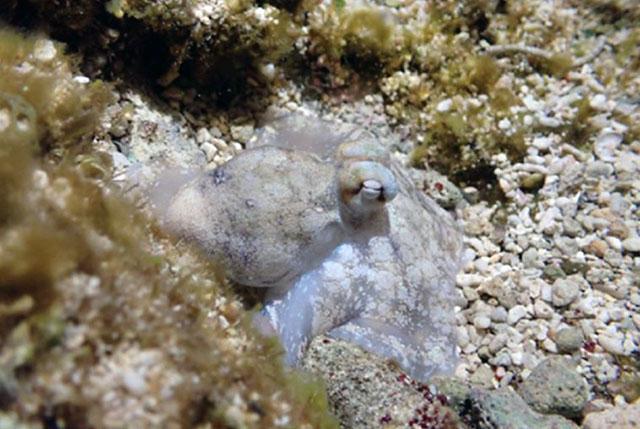
Octopus sleep shifts between quiet and frenzied stages
Scientists trace brain activity and skin patterning during active sleep in these invertebrates.Media Contact:
- UW Medicine: Leila Gray - leilag@uw.edu, 206-475-9808
- Okinawa Institute of Science and Technology: Dani Elenby - danielle.elenby1@OIST.jp; Tomon Okubo: tomoni.okubo@oist.jp

Octopuses, those smart, eight-armed mollusks, transition between two sleep stages, quiet and active.
Their quiet periods of slumber are punctuated by short bursts of frenzied activity. Their arms and eyes twitch, their breathing rate quickens, and their skin flashes with vibrant colors.
Researchers from the Okinawa Institute of Science and Technology in Japan, in collaboration with a postdoctoral fellow at UW Medicine, have closely examined the brain activity and skin patterning in Octopus laqueus during the active period of sleep. The scientists discovered that these closely resemble neural activity and skin patterning behavior when the animals are awake.
Wake-like activity also occurs during rapid eye movement, or REM, sleep in mammals, the phase in which most dreams occur.
The study, published 28 June in Nature, highlights some similarities between the sleeping behavior of octopuses and humans and offers some insights into the origin and function of sleep.
“All animals seem to show some form of sleep, even simple animals like jellyfish and fruit flies. But for a long time, only vertebrates were known to cycle between two different sleep stages,” said senior author Sam Reiter, who leads the Computational Neuroethology Unit at OIST.
“The fact that two-stage sleep has independently evolved in distantly related creatures, like octopuses, which have large but completely different brain structures from vertebrates, suggests that possessing an active, wake-like stage may be a general feature of complex cognition,” said one of the authors of the paper, Leenoy Meshulam, a theoretical physicist and Swartz Fellow in the Department of Physiology and Biophysics at the University of Washington School of Medicine and the UW Computational Neuroscience Center.
Meshulam applied mathematical language and computational analysis techniques from physics to construct theories and models that allowed the team to interpret the octopus’ brainwave recordings and changing skin patterns. Meshulam conducted the work during her three-month stay at the Okinawa Institute of Science and Technology as a guest of the Theoretical Sciences Visiting Program.
First, the scientists checked whether the octopuses were truly asleep during this active period. They found that when in both the quiet and active stage of sleep, the octopuses required stronger stimulation before reacting, compared to when they were awake. The team also discovered that if they prevented the octopuses from sleeping, or disrupted them during the active phase of sleep, the octopuses later entered active sleep sooner and more frequently.
“This compensatory behavior nails down the active stage as being an essential stage of sleep that is needed for octopuses to properly function,” said Aditi Pophale, co-first author of the study and a Ph.D. student at the Okinawa Institute of Science and Technology.
The researchers also delved into the brain activity of the octopuses when awake and asleep. During quiet sleep, the scientists saw characteristic brain waves that closely resemble certain waveforms seen during non-REM sleep in mammalian brains called sleep spindles.
Although the exact function of these waveforms is unclear even in humans, scientists believe they aid in consolidating memories. Using a cutting-edge microscope built by co-first author Tomoyuki Mano of the Okinawa Institute of Science and Technology, the researchers determined that these sleep spindle-like waves occur in regions of the octopuses’ brains associated with learning and memory.
Roughly once an hour, the octopuses entered an active sleep phase for around a minute. During this stage, the octopuses’ brain activity closely resembled what occurs while they are awake.
Using ultra-high 8K resolution, the group also captured and analyzed the changing skin patterns of the octopuses when awake and asleep.
“By filming in such high resolution, we can see how each individual pigmented cell behaves in order to create an overall skin pattern,” said Meshulam. “This could help us create simple skin pattern models to understand the general principles of waking and sleeping patterning behavior.”
When awake, octopuses control thousands of tiny, pigmented cells in their skin to create a vast array of skin patterns. They use these patterns to camouflage themselves in different environments, as well as in social or threat displays, such as warning off predators and communicating with each other. The scientists reported that the octopuses cycled through these same skin patterns during active sleep..
The similarities between active sleep and awake states could be explained by a variety of reasons, said the scientists. One theory is that octopuses may be practicing their skin patterns to improve their waking camouflage behavior, or simply maintaining the pigment cells.
Another intriguing idea is that the octopuses could be re-living and learning from their waking experiences, such as hunting or hiding from a predator, and reactivating the skin pattern associated with each experience. In other words, they could be doing something similar to dreaming.
“In this sense, while humans can verbally report what kind of dreams they had only once they wake, the octopuses’ skin pattern acts as a visual readout of their brain activity during sleep,” said Reiter.
He added, “We currently don’t know which of these explanations, if any, could be correct. We are very interested in investigating further.”
Today's Nature paper is titled: Wake-like skin patterning and neural activity during octopus sleep.
For details about UW Medicine, please visit https://uwmedicine.org/about.